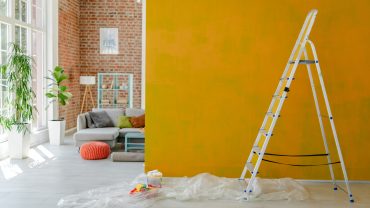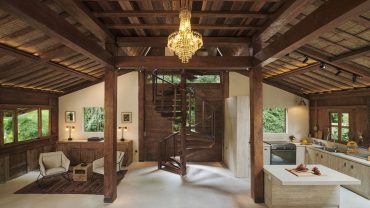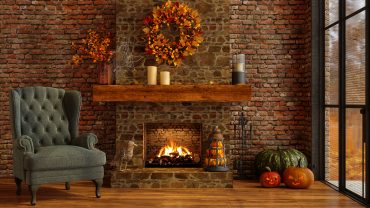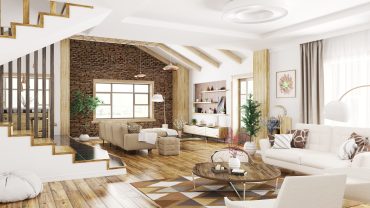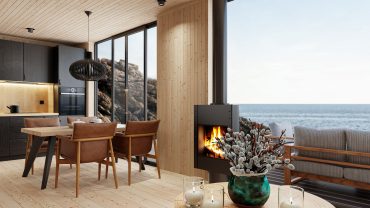When minimalist painter Frank Stella said ‘what you see is what you see’, he neatly summed up the simplicity and openness of the minimalist art movement and, by extension, minimalist interior design. But many equate this philosophy turned design field with clinical monochrome coldness. In fact, all is not as black-and-white as it at first seems.
Which rather begs the question, what is minimalist interior design? It’s a back-to-basic mentality that translates into an aesthetic of simplicity and functionality. It reduces elements to their essential qualities to achieve a sense of tranquillity and order. Want to know more? We’re exploring its history, principles and what it takes to design minimalist interiors.
A History of Minimalist Interior Design

Minimalist style living room interior. (Credit: Tanyawan Pensawat via Getty Images)
Minimalist home decor and design may seem like a modern trend, but it has deep historical roots spanning cultures and centuries. For instance, it echoes the traditional Japanese concepts of “Ma” and “Wabi-Sabi,” the former extolling the use of empty space as an essential part of design, the latter lauding imperfection, favouring simplicity and natural materials.
Similarly, the early 20th century Dutch De Stijl art movement also emphasised simplicity. Added to this was a focus on basic colour palettes and shapes. De Stijl influenced Germany’s Bauhaus school, which linked function and form. And the Bauhaus philosophy of “less is more,” popularised by architect Ludwig Mies van der Rohe, became a foundational element of minimalist design.
It was in the 1960s and 1970s that minimalist art further defined and popularised the movement. Characterised by simple, geometric shapes and a lack of narrative or symbolism, it had a profound impact on all forms of design, embracing clean lines and a focus on the intrinsic qualities of materials. And it was from this that minimalist interior design began to crystallise.
What is Minimalist Interior Design?

Minimal modern home design with warm furniture. (Credit: Lilas Gh via Getty Images)
At its very core, minimalism is an ideology of pure simplicity and calm. It promotes living with what one needs and no more, making it compatible with sustainability and mindfulness. In design, this translates as a pared back environment in which quality overrides quantity and where individual items, not to mention flaws, draw focus.
Now, beyond this, answering the question “what is minimalist interior design” is largely dependent on what it isn’t. Because, as we’ll see, it’s actually much more versatile and less prescriptive than it’s usually portrayed. With that in mind, let’s look at what it takes to design minimalist interiors.
Clutter-Free Spaces
One of the most recognizable aspects of minimalist home decor is the absence of… well… very much decor. Every item in a minimalist space is selected with care and purpose, and there is a strong emphasis on keeping surfaces clean and clear. This not only contributes to the aesthetic appeal but also promotes a sense of peace and order. Storage solutions are key in a minimalist home, as they allow for necessary items to be neatly tucked away, maintaining the clean lines and open feel of the space.
Simplicity in Form and Function
So, as we’ve identified, simplicity is key to minimalism. This involves stripping away non-essential items and focusing on the functionality of the space. Furniture and decor are chosen for their practicality and clean lines, often featuring geometric shapes and smooth surfaces. This simplicity extends to colour schemes, where a minimalist house design usually incorporates a monochromatic or limited colour palette to create a cohesive and calming environment.
Limited Colour Palettes
The widespread portrayal of minimalist interior design is one of a palette consisting only of black and white. In fact, there’s nothing to restrict designs to these two options. A limited, perhaps even subdued or neutral, set of shades is often used to promote calm, but is not prescribed. So there’s nothing to stop a bolder colour popping in, as long as it’s done sparingly.
Quality Over Quantity
Minimalism focuses on quality rather than quantity. This means choosing fewer, but better-made and more meaningful, items. Furniture and decor in minimalist house design are often characterised by their craftsmanship and durability. This approach not only contributes to the overall aesthetic but also promotes sustainability and mindful consumption.
Emphasis on Texture and Material
Texture and material play a significant role in minimalist interior design. The use of natural materials such as wood, stone, and metal adds warmth and interest to the space. Textural contrasts, such as a soft wool rug against a sleek wooden floor, can create visual interest and add depth and richness to minimalist home decor without overwhelming the space.
Natural Light and Open Spaces
Minimalist interior design often maximises natural light and open spaces. Large windows, unadorned or with simple treatments, allow light to flood into the rooms, enhancing the sense of openness. Open floor plans are common in minimalist house design, with spaces flowing seamlessly into one another. This openness not only makes the home feel larger but also fosters a sense of tranquillity and freedom.
Art and Personal Touches
While minimalist interior design is often associated with starkness, it doesn’t mean spaces should be devoid of personality. Artwork and personal touches are important in creating a home that feels warm and lived-in. However, in keeping with the minimalist ethos, these elements are chosen thoughtfully and displayed sparingly. A single piece of striking artwork or a carefully selected collection of items can add character to the space without detracting from the minimalist aesthetic.
Summarising Minimalist Interior Design

A minimal styled bedroom with grey wall. (Credit: runna10 via Getty Images)
As we’ve seen, minimalist house design is more than just an aesthetic choice; it’s a philosophy which embraces simplicity, functionality, and mindfulness. By focusing on the essential elements of a space, minimalist home decor creates an environment that’s both serene and sophisticated.




